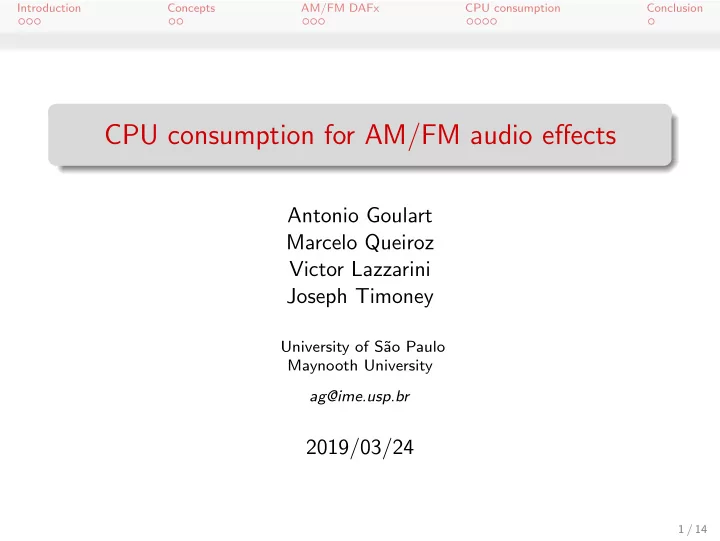

Introduction Concepts AM/FM DAFx CPU consumption Conclusion CPU consumption for AM/FM audio effects Antonio Goulart Marcelo Queiroz Victor Lazzarini Joseph Timoney University of S˜ ao Paulo Maynooth University ag@ime.usp.br 2019/03/24 1 / 14
Introduction Concepts AM/FM DAFx CPU consumption Conclusion Audio effects “I feel that the processing is only there to emphasize things that are already there ... I’m never very interested in the kind of sound processing that leads me way too far away from the original sound, unless it really makes connections.” Hildegard Westerkamp 2 / 14
Introduction Concepts AM/FM DAFx CPU consumption Conclusion AM/FM framework �� t � y ( t ) = a ( t ) cos f ( τ ) d τ 0 a ( t ) envelope AM (ring mod) synth f ( t ) instantaneous frequency (IF) FM/PM synth 3 / 14
Introduction Concepts AM/FM DAFx CPU consumption Conclusion Analysis / Processing / Resynthesis frameworks that offer an alternative domain (to think about the sound) Fourier analysis already familiar Envelope + instantaneous Frequency domain correlates frequency well to musical aspects like bass, treble, etc Different perspective to think about effects Computed on chunks of the signal Computed on a sample-by-sample basis (all-pass filters approach) 4 / 14
Introduction Concepts AM/FM DAFx CPU consumption Conclusion Analytic signal for x ( t ) ∈ R � + ∞ x ( t ) e − i ω t dt X ( ω ) = −∞ � + ∞ z ( t ) = 1 X ( ω ) e i ω t d ω 2 π 0 5 / 14
Introduction Concepts AM/FM DAFx CPU consumption Conclusion Hilbert Transform based decomposition ˆ x ( t ) in quadrature with x ( t ) z ( t ) = x ( t ) + i ˆ x ( t ) Envelope radius � x 2 ( t ) + ˆ x 2 ( t ) = | z ( t ) | a ( t ) = Phase � ˆ � x ( t ) φ ( t ) = arctan x ( t ) Instantaneous frequency increment f ( t ) = ˙ φ ( t ) Time-varying phasor z ( t ) = a ( t ) e i φ ( t ) 6 / 14
Introduction Concepts AM/FM DAFx CPU consumption Conclusion AM/FM DAFx The effects are based on envelope / instantaneous frequency manipulations, followed by the resynthesis step A nice example: the octIFer (our AM/FM octaver) based on multiplying the IF samples by 0.5 in such a way the phasor increments are constrained, resulting in a lower register sound 7 / 14
Introduction Concepts AM/FM DAFx CPU consumption Conclusion sqENVerb – reverb enhancer based on extracting the square root of the envelope samples [0 , 1] → [0 , 1] √ x 1 = √ x x lower envelope values will result in a higher relative gain 8 / 14
Introduction Concepts AM/FM DAFx CPU consumption Conclusion sqENVerb – reverb enhancer 9 / 14
Introduction Concepts AM/FM DAFx CPU consumption Conclusion Motivation artistic considerations (e.g. maximum tolerated latencies) technical considerations (e.g. hardware sizing) mobile/weak/old computers: RaspberryPi 2B / quad-core ARM Cortex-A7 @ 900 MHz 32 bits / 1 GB SD-RAM @ 400 MHz / Raspbian / Csound 6.08 strong/game computers: ThinkPad x220 / dual-core i5-2520M @ 2.5 GHz 64 bits / 8 GB RAM DDR3 @ 1333 MHz / Debian / Csound 6.09.1 44100 samples per second 10 / 14
Introduction Concepts AM/FM DAFx CPU consumption Conclusion Methodology time csound amfmdafx.csd real: total duration of the process under analysis; user: time taken to work directly on the process; sys: time taken to work on system tasks related to the process. CPU (%) = user + sys real 11 / 14
Introduction Concepts AM/FM DAFx CPU consumption Conclusion CPU consumption for AM/FM DAFx FFT pair = FFT followed by iFFT AM/FM framework = envelope and IF computation, followed by resynthesis CPU consumption (%) RaspberryPi 2B ThinkPad x220 looped audio 9.49 4.69 clip distortion 10.77 5.06 FFT pair (1024/512) 26.35 8.52 FFT pair (1024/256) 37.38 10.37 FFT pair (1024/128) 45.76 12.31 FFT pair (512/256) 26.05 8.68 FFT pair (512/128) 33.68 10.47 AM/FM framework 25.23 7.53 12 / 14
Introduction Concepts AM/FM DAFx CPU consumption Conclusion CPU consumption for AM/FM DAFx CPU consumption (%) RaspberryPi 2B ThinkPad x220 FFT octaver (1024/128) 48.00 12.41 convolution reverb 2500 88.98 14.73 convolution reverb 5000 ): 22.97 simulation reverb 26.13 7.67 AM/FM IF filtering 29.72 7.73 AM/FM IF compression 33.21 7.78 AM/FM IF modulation 29.23 7.92 AM/FM octIFer 29.87 7.81 AM/FM sqENVerb 28.51 7.77 13 / 14
Introduction Concepts AM/FM DAFx CPU consumption Conclusion Conclusion envelope / instantaneous frequency: a decomposition that offers an alternative domain for DAFx subtle modifications might result in interesting effects good reverb and octaver sounds, at a low computational cost decomposition in this study was mono-component; tracking fundamental frequency and adding more oscillators will raise computational cost Thanks a lot! Sorry for not being there ): 14 / 14
Recommend
More recommend